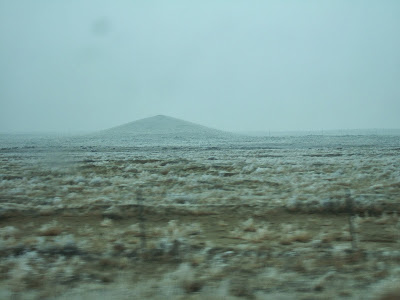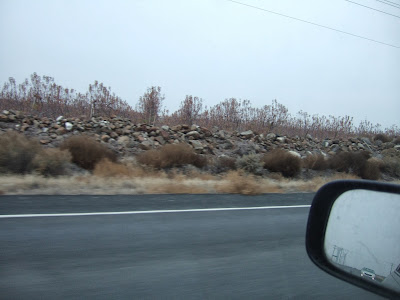I drove from Richland to Vantage as part of a longer drive from eastern Washington back to home in Bellingham. Temperatures had moderated a bit but it was still below freezing and foggy within the inversion of cold air trapped in the low areas. Not much in the way of views and I made no stops. All the same a few notes on this drive.
The first part of the drive on State Highway 240 cuts across the Hanford Area. This was and still is part of the large reserve of land taken for manufacturing fuel for nuclear weapons during WWII and the cold war. A large part of the area is wild land and has since been designated as part of the Hanford Reach National Monument. The highway traverses between the still active nuclear reserve and the National Monument and public access is still out of bounds all along the road.
Cold Creek Valley and an invisible Rattlensnake Mountain
The fog completely hid Rattlesnake. This mountain reaches 3,600 feet rising well over 3,000 feet above the floor of Cold Creek valley. Cold Creek is rather unique in Washington State - future post. I will say if you see it flowing along this section of the valley you would be witnessing a very rare event. The valley along this reach was formed by ice-age flood water.
Goose Egg Hill
It was clear enough to see Goose Egg Hill. It is essentially impossible to gage the height of this hill. It rises about 80 feet above the surrounding plain. I have a arm waving theory on it (
goose-egg-hill-Hanford).
After a long straight and flat stretch and just past Goose Egg Hill the road rises up a slope. This is the Cold Creek Bar, a deposit of sand and gravel from ice-age floods where the flood waters lost velocity. If you have a sharp eye there are some lumps of boulders on this bar where ice bergs grounded and melted leaving behind boulders from Montana, Idaho and Canada.
The road crosses the top of the Cold Creek Bar and then drops down the very steep and high upstream end of the bar down to the valley floor of the Columbia River and crosses the Columbia at Vernita (no town).
Vernita Bridge and the huge Priest Rapids Bar
Crossing the river the road aims directly at the high Priest Rapids Bar, another deflation gravel bar from the ice-age floods. The gravel bar rises over 300 feet above the river.
Yes, the bar is made of gravel - lots of it
The route then parallels the Columbia with views across the river to the steep north slope of Umtanum Ridge. Rather obscured on this day due to fog, but otherwise a complex slope of faults, folds and large landslides that rises very abruptly 1,800 feet above the river. Umtanum is one of several Yakima Fold Belt ridges.
Umtanum rising into the fog
After miles of crossing the driest part of the state the road enters back into farm land of mostly orchards and vineyards. This area is some of most recent area served by the Columbia Basin project and is fed with water from the Columbia River via the Grande Coulee Dam. Besides the effort to get water to this dry landscape, many of the orchards and vineyards included lots of boulder removal and piles of boulders line the perimeter of a series of orchards and vineyards.
Boulders and apple orchard near Mattawa
The high velocity of the ice-age flood waters is due to the tight narrow constriction at Sentinel Gap where the Columbia River cuts through the Saddle Mountains, a ridge on the northern part of the Yakima Fold Belt.
Remnant gravel bar and steep slopes of Sentinel Gap
View west across Sentinel Gap
The cliffs on the north side of Sentinel Gap are a spectacular mountain cliff front with steep talus rising sharply nearly 2,000 feet above the river.






















































